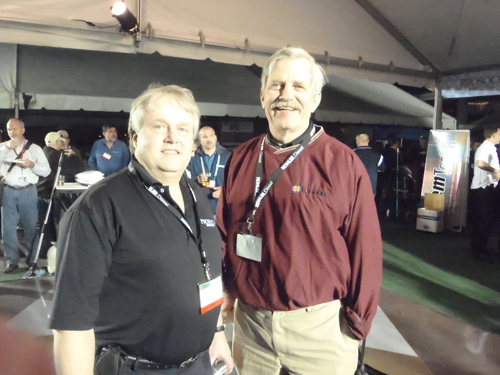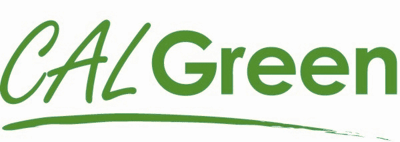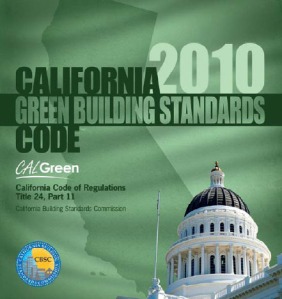Passive House Mini-B is fascinating on two fronts.
First — it’s so little! Mini-B (short for Mini-Bungalow) is an entire cottage in just 300 square feet. You can plop it down in the back yard for a guest house or on a lot in the woods for a vacation hideout.
Yet it’s got living, sleeping, and cooking quarters and even some limited storage space. It’s got high ceilings and huge front windows.
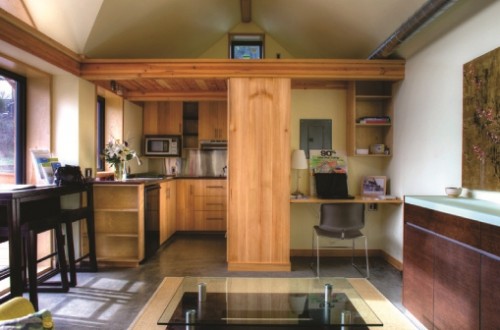
Despite a compact foorprint, Mini-B offers living, cooking and sleeping quarters. The cabinets are spruce.
The other thing that’s fascinating about Mini-B is that it’s a Passive House. It uses about 10 percent of the heating energy of a similar dwelling built by conventional means.
Designer Joe Giampietro, Johnson Braund Design Group, Seattle, showed the newly built prototype off to the public with a grand opening Jan. 15 at the Phinney Ridge Neighborhood Center, also in Seattle.
It garnered a lot of attention, Joe said — more than 100 visitors in three hours, including the Seattle Times. Sixty more showed up to look over the little house at a private showing last weekend.
“The Seattle Times article had people coming by every day to peer in the windows and asking to see the inside,” Joe said. “We had to open the windows to cool off with all the warm bodies heating the house!”
Mini-B’s tiny footprint and huge energy-efficiency is getting attention from other local media including the Seattle Channel, Adventure TV and King 5 TV, Joe said.
The Passive House Institute U.S. pre-certified Mini-B’s energy-saving design before construction began last Spring. Carpentry students at Seattle Central Community College built the prototype Mini-B, supervised by instructor Frank Mestemacher.
A blower door test confirmed the little house’s air-tightness in July. The air-tightness, an important part of that energy-efficiency, comes from the PROSOCO R-GUARD Air & Waterproof Barrier on the structural walls.
R-GUARD products cover the structural wall with a seamless, continuous, durable, breathable barrier that stops costly air leakage through the building envelope.
Air-tightness, combined with heavy insulation — 9-inch styrofoam and blown-in fiberglass insulation — means a little heat goes a long ways. Heat energy loss is small — so are the bills.
Joe, Frank and research scientist Tom Schneider of BEI (Building Envelope Innovations), Seattle, the inventors of the R-GUARD products used, were there for the unveiling, answering questions.
The floor is 1 1/2-inch concrete, treated with PROSOCO’s Consolideck LS (lithium-silicate) Hardener/Densifier. In addition to making the floor more durable, LS is third-party certified by Scientific Certification Systems, Emeryville, Calif., to meet the nation’s highest standards for indoor air-quality.
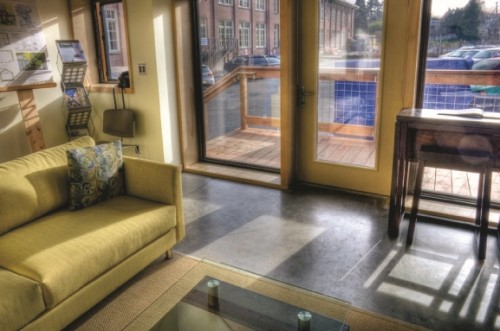
Consolideck LS (lithium-silicate) hardened, densified and dustproofed Mini-B's exposed concrete floor.
Mini-B features spruce cabinets; Georgia Pacific’s Dens Armor Plus drywall; and low-VOC paints and finishes throughout, Joe said. He plans to sell the house in July, then build additional Mini-Bs for sale.
Photos by Steve Allwine

Passive House Mini-B, designed by Joe Giampietro, built by students at Seattle Central Community College, reduces heat energy use and cost by nearly 90 percent compared to a comparable structure built with traditional methods and materials.
# # #




